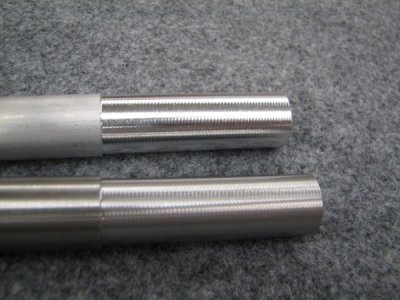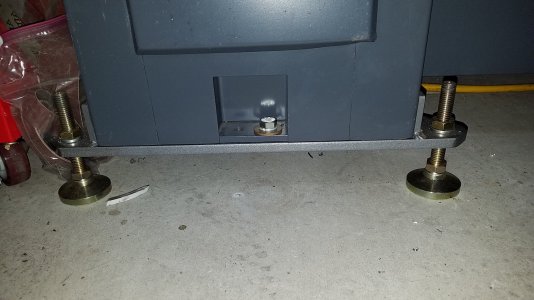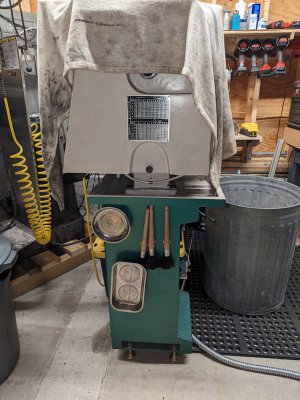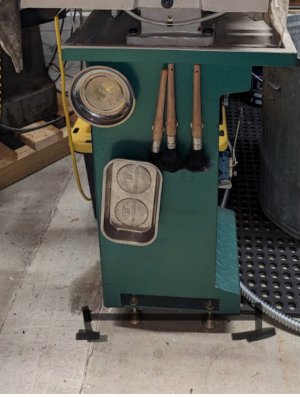- Joined
- Jun 12, 2014
- Messages
- 4,817
Years ago there was a similar controversy about the 1340GT, the initial versions the base used thinner metal and only had on set of mounting feet on the headstock cabinet. There would be resonant frequencies and the lathe would vibrate at certain speeds. Bolting the base to the floor did not remedy the situation as the issue was flexing of the cabinet. People (including myself) added frames, stiffeners and plates on the top of the cabinets, between the cabinets and perimeter frames on the base. They did work to some degree, but you have a lot of weight high up and narrow feet spacing. Eventually they increased the cabinet metal thickness and went to four mounting feet on the hedstock cabinet, and even offered a cast iron base at one point. The problem resolved, I am not aware of anybody needing to bolt their lathe to the floor. They do not indicate bolting the lathe to the floor either.
The older Grizzly G4003G use to have cast iron bases if I recall and at some point there were some posts saying they switch to rolled steel which does not have as good a dampening characteristics. Some people went as far to put concrete in the base or sandbags in the cabinet. The G4003G for its size is still quite heavy at around 1500 lbs with the base, I do not see the need/benefit of bolting it to the ground. Using good mounting feet (Like S&W leveling feet is recommended, or larger diameter steel discs or pucks with a leveling screw). My current lathe is 2400 lbs, it uses 3" diameter cast iron pucks with a central divot for the leveling screw, I have those sitting on some 1/8" thick square of HDPE to prevent the feet from digging into the concrete floor/paint.
I see no benefit of bolting it to the floor, if leveling a lathe you want to allow it to naturally settle and then recheck it, let gravity do its job. There are cases where rigid mounting to the floor is beneficial, and other cases where it does not allow sufficient movement and there can be structural failure if there is not some form of isolation mount. Manual lathes, I have always heard that they should use solid feet (as opposed to isolation type). I initially tried heavy duty isolation feet on my 1340GT and it helped somewhat with vibration, but leveling would not stay stable. I eventually added steel plates, and 4 level feet with a wider stance to my headstock cabinet which worked.
If you are going to raise the base, then you may want to make a perimeter steel base and widen the stance, or something similar.
If you are worried about vibration, one upgrade for the G4003G is switching the motor over to 3 phase, there were quite a few reports of the single phase motor pulsations showing up in the turning patterns.
Single phase motor vibrations in turning aluminum and steel. It seems to be highly variable as to the occurrence, in this case it was resolved replacing the motor with a 3 phase + VFD.

Headstock cabinet converter to 4 adjustable S&W leveling feet with wider stance and 1/2" plate steel braces.


The older Grizzly G4003G use to have cast iron bases if I recall and at some point there were some posts saying they switch to rolled steel which does not have as good a dampening characteristics. Some people went as far to put concrete in the base or sandbags in the cabinet. The G4003G for its size is still quite heavy at around 1500 lbs with the base, I do not see the need/benefit of bolting it to the ground. Using good mounting feet (Like S&W leveling feet is recommended, or larger diameter steel discs or pucks with a leveling screw). My current lathe is 2400 lbs, it uses 3" diameter cast iron pucks with a central divot for the leveling screw, I have those sitting on some 1/8" thick square of HDPE to prevent the feet from digging into the concrete floor/paint.
I see no benefit of bolting it to the floor, if leveling a lathe you want to allow it to naturally settle and then recheck it, let gravity do its job. There are cases where rigid mounting to the floor is beneficial, and other cases where it does not allow sufficient movement and there can be structural failure if there is not some form of isolation mount. Manual lathes, I have always heard that they should use solid feet (as opposed to isolation type). I initially tried heavy duty isolation feet on my 1340GT and it helped somewhat with vibration, but leveling would not stay stable. I eventually added steel plates, and 4 level feet with a wider stance to my headstock cabinet which worked.
If you are going to raise the base, then you may want to make a perimeter steel base and widen the stance, or something similar.
If you are worried about vibration, one upgrade for the G4003G is switching the motor over to 3 phase, there were quite a few reports of the single phase motor pulsations showing up in the turning patterns.
Single phase motor vibrations in turning aluminum and steel. It seems to be highly variable as to the occurrence, in this case it was resolved replacing the motor with a 3 phase + VFD.

Headstock cabinet converter to 4 adjustable S&W leveling feet with wider stance and 1/2" plate steel braces.





